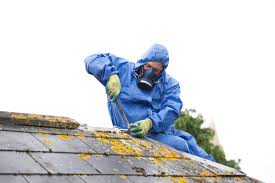Asbestos is a naturally occurring mineral made up of extremely small fibres. It was used in building construction commonly between 1945 and 1985 but was banned from use when the risks it can potentially bring were identified.
On average 20 tradesmen die every week as a result of asbestos exposure. Building contractors, plumbers, electricians and decorators are particularly at risk because they might interact with asbestos without realising that they are.
The management and responsibility of asbestos are laid out in Regulation 4 of the Control of Asbestos Regulations 2012.
You are most likely to uncover asbestos in a number of places:
- Sprayed asbestos and asbestos loose packing, which is being used as fire protection
- Moulded or pre-formed lagging used as thermal insulation to pipes and boilers
- Asbestos Insulating Board used for fire protection and thermal insulation or as partitions and ducting
- Asbestos cement products which have most lily been moulded into corrugated roofing sheets, cladding, guttering, downpipes, flues and water tanks
If asbestos material is disturbed or if they are in poor condition, they release a huge number of needle-shaped fibres which can be inhaled into the lungs. These fibres can then lodge in the lungs and can lead to several diseases a number of which are fatal, namely lung cancer, asbestosis or mesothelioma. Click here, to learn more from the government.
Frighteningly your home has a 50% chance of containing asbestos but experts say that if the asbestos is not disturbed you are at little risk of harmful exposure, but the sites or pockets where asbestos may be harbouring must be regularly checked as a preventative measure
Who is responsible for maintenance or repair?
If you are responsible for maintenance or repair of premises or equipment, you are the duty holder and will need to follow the next steps, but this only applies to the following:
- All non-domestic premises
- The common parts of domestic premises
Testing for Asbestos
If you are not planning on undertaking any works and you have had your premises checked previously for asbestos you do not need to worry. But if on the other hand, there are a number of surveys you can have performed to determine asbestos’s presence:
- Asbestos management survey
- Refurbishment/Demolition survey
- Brownfield Sites asbestos survey
- Old Equipment pre-2000 guidance service
N.B. Before undertaking any asbestos work you are legally obliged to inform those at risk of any works you have planned.
Removing Asbestos
We highly recommend bringing in a professional to remove asbestos but if you believe you are qualified to remove it yourself then there are a number of steps you can take to do so.
The link below will take you to a website which will allow you to get in touch with someone to help you remove the asbestos from your home.
Before beginning asbestos removal work, however, it is essential that either yourself or contractors complete the ASB5 form and return it to the Health and Safety Team before starting.
Competence for removing asbestos is something that is formulated over time not just by taking a simple course, however, the recommended information is often learnt through the book in the link attached.
If you are in the process of moving house, consider taking out a bridging loan to save yourself the stress of waiting for a mortgage to clear and potentially losing your property altogether.
